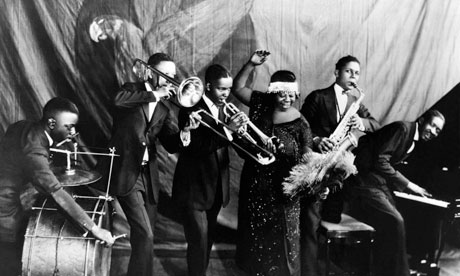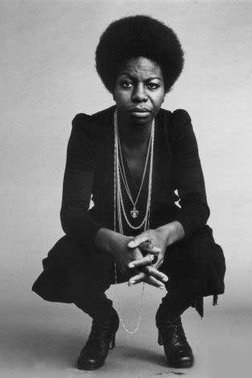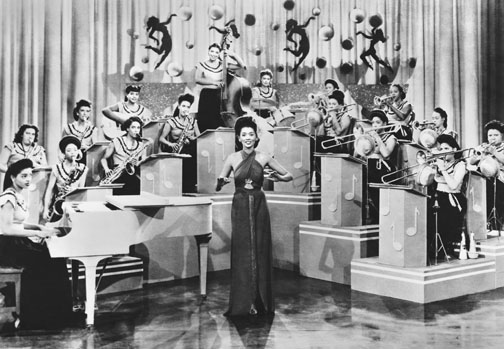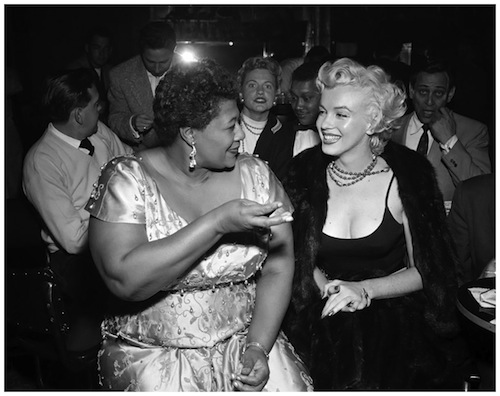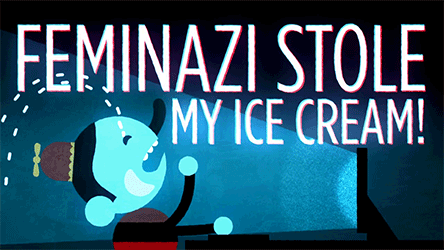An issue of Scholar & Feminist Online devoted to Josephine Baker: Josephine Baker: a Century in the Spotlight, edited by Kaiama L. Glover.
Category Archives: wimminz
Chorus lines and women dancers
Plenty of Good Women Dancers exhibition
This Philadelphia Folklore Project exhibition is fantastic.
Note to self: chase down Lee Ellen Friedland’s latest work, as her project on tap dancers in Philadelphia was so important to my own work. And apparently she’s done work on jewish folk dances, which is important for talk about NOLA music and dance. And this exhibit’s host is based in Philadelphia.
NB I don’t have to explain why this exhibit is important, do I? Ok, I will anyway.
1) Women dancers. BOOM.
2) Chorus line projects are tres chic in the lindy hop world. The most interesting one I’ve seen so far is Marie N’Diaye’s project in Stockholm, where they’re based in the Chicago studio, and perform at Herrang, week in and week out. I had no idea just how intense and hardcore this project is until I saw Marie’s footage and spoke to her about their training and choreographing work load. This shit is intense.
3) A lot of the biggest name women dancers began in chorus lines. Josephine Baker. Marie Bryant. etc etc etc.
4) These women dancers were insanely fit and strong. They would be performing multiple times during the day, learning new routine every week, singing, dancing, tapping, jazzing, etc etc etc. These were dancing machines. And yet they were often dismissed as bits of fluff.
5) Managing chorus lines was a way for women dancers to participate in the entertainment industry as professionals with serious industry power.
6) Running chorus lines today is just as important for women dancers now as it was then: women working together, running serious projects, training bloody hard, learning to choreograph, run a troupe and dance business, generally be awesome.
7) Being in a chorus line is hard work, and a way for modern women dancers to get mad skills: fitness, strength, memory, quick learning skills, choreography, etc etc etc.
8) Chorus lines are a way for modern women dancers to sidestep the bullshit power politics of dancing and competing with male partners in the lindy hop world. And yet still get mad dance skills that improve their lindy hop.
Here are the rules.
Hello!
I’ve recently had a bunch of traffic redirected here, and that means lots of first time visitors dropping in. Nice to see you!
I want to let you know about my comments policy. It’s strict. Here are the rules:
1. If you get all up in my business with aggressive, threatening, or nasty comments, your comment will be deleted. If you need to rant, get your own blog.
2. I have zero tolerance for sexism, racism or other unpleasantness. Your comment will be deleted. Your opinions simply aren’t important.
3. This is a feminist space. That means we’re assuming you’re on board with feminist principles. I am not interested in debating your ideas about feminism. If you use the terms ‘misandry’ or ‘reverse sexism’ or try to argue that a woman is being sexist, your comment will be deleted. If you can’t dig that, you need to leave. If you don’t understand why, you need to read feminism 101.
Why so strict?
Even though my positions on most issues of gender, sex, power and lindy hop are relatively moderate (I’m not a radical feminist, sadly), I regularly receive hateful emails, messages on facebook, and comments on this blog. It’s frightening and unpleasant and it makes me angry. Rather than dwell on the insecurities of men who want to bully women who use their brains, I delete them. I don’t even bother reading them. I will not be bullied out of thinking or speaking or doing. Nor will I hesitate to call the police or report your arse for harassing me.
Nor do I feel any responsibility to let people who disagree with me ‘have their say’. The world is full of forums for anti-feminist and anti-woman talk. This is not one of them. This is an actively feminist space. This is a feminist echo chamber. In this world, the rules are that gender is important, that women have things to say, that their opinions will be given greater value than men’s, and that solo dance is an essential part of lindy hop. I am the boss of this blog, and my word rules.
I’ve talked more about my policies in this post. I will not be entering into any arguments or discussions with you about these policies. If you want a forum to air your ideas, get a blog.
While I’m at it: please note that I will not engage with you on these issues in person, either. If I’m out at a dance, I am there to dance or to DJ. I rarely want to talk politics when I’m lindy hopping. I rarely want to talk about my blog or online talk in general.
If, however, you are a woman who wants to talk about activism in your scene, bring it! I am very interested.
If you are a woman interested in getting into DJing or leading or solo dance, bring that too – I am interested.
Yes, I am privileging women here. That is the deal.
Herräng report: part 1
Well, it’s 6.30am, and I’ve been awake since 5. My sleep cycle is well and truly borked. Curse you, jet lag. Why is that staying awake while flying around the world in a plane is more disruptive than staying awake dancing, eating, laughing, and talking in irregular patterns over several weeks?
I’m back from two weeks in Herräng (weeks 2 and 3), and a bit of time in Stockholm, and I’m taking a few days before I go back to work. It’d been ten years since I’d been to Herräng, and things had changed a bit. For one, things were more organised, which was a relief. The scale had also leapt: more places to eat, more people, more dance floors, more things to do. I was there to dance and DJ this time, rather than to ‘research’, so I approached each day in a different way.
I have lots of things to talk about, but I can’t quite keep hold of my thoughts, so I’m not sure how coherent this will be. Things I’d like to talk about, in no particular order:
- the ‘how to DJ session’ in the library in week 3;
- the way the insistence that Herräng is about lindy hop, and lindy hop is ‘such a happy dance’ makes it difficult to talk about problems or serious issues within the dance and event;
- the somewhat disturbingly uncritical ‘spread the dance/grow the community’ discourse that dominates and justifies most activities (including a particular brand of cultural imperialism);
- gender politics in the DJing and dancing culture of the camp (and the way critical engagement with this is forestalled by the ‘let’s just have a nice time/hedonism is us’ vibe);
- the sheer joy and wonder of the Frankie Track in week 2;
- teaching practice, and the balance between content and practice;
- the effects of a coherent teaching approach in the Frankie Track versus the usual overall relationship between individual workshops at a dance weekend. I will say this: the Frankie Track was amazeballs because all the classes were linked by a coherent theme and concept: teaching Frankie Manning’s content, teaching classes in the way he taught classes, emphasising his priorities (MUSIC! PARTNERSHIP! SIMPLICITY! RHYTHM!), drawing on the old timers’ approach to learning dance generally…. and MORE;
- the challenges and excitement of the beginners’ half week of tap in week 3;
- the ebb and flow of energy and people and vibe over the course of a week;
- economic factors and the effect of the Herräng Dance Camp’s decades of involvement in this small town’s economy and society;
- the Swing Kids, Swing Teens and the way having children in the camp in week 2 provided social balance to the ‘hedonism’ of the camp, which was largely lost by the end of week 3;
- hierarchies, power, and privilege in the camp;
- the wheeling and dealing and networking and lobbying for work behind the scenes, from teachers, DJs, and organisers;
- labour, work, gender, and knowledge in the Herräng economy;
- mindfulness, computer literacy and online culture in camp (and how this had changed in the ten years since my last visit);
- mindfulness, work, obsessive personalities, and the luxury of time in tap dance;
- the argument that all DJs should learn to play a musical instrument if they want to be ‘good DJs’ (and the associated issues of power, time, labour, gender, and power);
- sex, sexualisation, gender, and scoring a root;
- the significance of Herräng’s place in Europe, and how this affected people’s attitudes to same-sex sex and gender. And how these progressive attitudes were ultimately subsumed or overshadowed by the overwhelming heteronormativity of modern lindy hop;
- food, nutrition, body image, and the importance of the shared table at Herräng: my favourite part;
- defining ‘swing’ music, and Herräng’s emphasis on classic swing era big band jazz, and how this affected DJing styles and set content, and dancers’ responses to music. Relatedly, the tension between modern day dancers’ learning to play music, the accessibility of small NOLA or hot combo style jazz versus the inaccessability of big band jazz for new musicians (ie dancers tend to play in small, hot combos which aren’t what Herräng values, but Herräng does value live music and independent creative projects very highly…. the tension needs a bit of discussion, I think);
As you can see, I have approximately one million things to write and talk about after my time in Herräng. One looming largest in my brains is DJing, as I was a staff DJ in week 2, and one of only 4 women out of 16 staff DJs in the 5 week camp. There were a number of volunteer DJs in the two weeks I was there, but not a whole bunch of them. A higher proportion of them were women than men.
I have a few things to say about how gender, networks of association and labour, and the professional skills required of DJs (primary of which is networking, in this case) work in Herräng, but I don’t really have the brains to articulate them properly here. In sum, though, I was very surprised by how few women DJs there were, after the last couple of years in Australia where women far outnumber men in the higher, most experienced ranks of lindy hop DJs. To the point where for the last MLX I had only one male DJ on the DJ team.
My approach to hiring DJs for events is to look for the most capable, most professional, most skilled, most useful and talented DJs, regardless of gender. They need to be not too over-exposed, and yet still have a degree of popularity with dancers (ie, be ‘in demand’). They might not be quite where they should be, in terms of experience or expanse of music collection, but I’m willing to invest in someone with promise and a good, strong work ethic.
I think that the reason I end up with more women than men, is that I actively seek out DJs, rather than waiting for them to approach me, and I put quite a bit of work into long term development for DJs. My own gender is probably significant too, though I’m often described as ‘intimidating’ by other women. But I’m very yolo about that: life is too short to worry about whether you intimidate other people. And I know other DJs and DJ organisers who are both male and very approachable.
I find that male DJs are more willing to put their hands up for gigs (to approach me for gigs) than women, and that women DJs are more critical of their own DJing, needing more encouragement, and also looking for more critical feedback on their DJing. The latter makes most women much better DJs (because they are open to improving, and open to communicating about their own DJing, and less defensive about their DJing), the former makes women less excellent at developing professional networks and ‘taking risks’ by applying for jobs they might not be ready for. They tend to play it too safe, and be more intimidated by hierarchies. There are male and female exceptions to these things, but very few. Very, very few.
My approach involves long term planning and development, including encouraging newer DJs, providing references and recommendations for new DJs with smaller events (so they can get the experience I need for the bigger events I work for), and keeping my local scene networks healthy – talking to people in different scenes to keep my finger on which DJs are looking and sounding good, and good to work with.
I’m also very keen on providing working conditions which make DJing more accessible for people: friendlier, safer, healthier, clearer (guidelines, etc), equitable pay, an open DJ recruitment process (so people know who to contact and how if they want to DJ, rather than using a quiet system of personal networks), and I am quite aggressive about getting feedback on my own work, and on the DJs’ experiences, so I can keep improving things. I think this transparency is the most important part of encouraging diversity in the DJing team: I am open about my ideas, process, and thinking.
Dargoff was the DJ coordinator for Herräng, and he was just a joy to work with. I don’t know his policies or approach to booking DJs for Herräng, so I can’t comment on them here, but I couldn’t find fault with his work. There are, however, broader systemic issues which make it harder for women to get into these higher profile DJing gigs which require active, fairly aggressive strategies from organisers to overcome. I simply don’t know enough about how Herräng works to be able to comment on this, though. And I don’t even know who organised the DJs in previous years. But I do have some ideas about international DJing culture, and most particularly DJing networks and interpersonal and professional associations which might be useful in this discussion. Again, my lack of experience here makes me reluctant to comment more. I have some ideas, but I just don’t think I know enough to start speculating.
So, when it comes to my experiences DJing at Herräng, I give it a big thumbs up, and I give all my fellow DJs, Dargoff, the huge sound crew, and the event organisers a big huzzah. It was a really great experience, and while challenging in some moments (looong sets are loooong), I would absolutely leap at a chance to do it again. I feel privileged and honoured to be a staff DJ at an event I admire so much, and I learnt SO MUCH about DJing over the two weeks I was there. I also made some new and good friends, and realised I have a lot to learn about the international DJing scene.
I also realised Australia is really isolated from the rest of the lindy hop world. This makes it harder for DJs to crack the higher echelons of DJing, but it has also had effects on our approach to labour and pay and professionalism. Overall, though, I’d say that Australia has quite a few DJs who are not only as good as, but better than some of the DJs I heard in Herräng, and that our lindy hop scene as a whole is something to be proud of. We aren’t a cultural backwater, we’re just a really distant tributary.
100 lols of loldom
Bat Country For Old Men
I was going to write about this on facebook, but I was just too damned scared.
I don’t write about provocative stuff much any more because I simply can’t handle the horrible emails, comments and hassling. Yeah, fuckwits, you won this round.
But I take my revenge by being a confident, capable woman working with other women to make safe dance spaces.
One of the reasons Blair is not called to account is fear. I interviewed a number of people in the course of researching this article. Almost all of them warned me about what would happen if I went ahead. Some were too afraid to go on the record about him because of the reaction it might incur. I was told that he would go through my social media photos, searching for images that he might be able to use to shame me, as he did with Clem Bastow. He would go back through all my published articles to find things he could misrepresent or misquote. That he would post about me and I’d be attacked on twitter and by email with vicious personal slurs. I understand this risk, fear of being trolled means many people remain silent about what he is doing. This is a problem, not for him, but for journalism (Jane Gilmore Bat Country for Old Men)
It’s worth noting that if you’re a woman commenting on racism or sexism or homophobia in the lindy hop community in a public forum, you’ll end up with a rash of fairly horrible comments, emails, and messages. We like to pretend that we are a lovely fairy floss community, but as Montreal’s recent troubles, various black face routines at international dance competitions, and reports of sexual assault in lindy hop scenes demonstrate, the dance might be happy, but the dancers are as likely to behave badly as non-dancers.
This is why I have a very strict comments regulation policy on my own blog, and I will not respond to unpleasant private messages on facebook. I also make liberal use of the block button, and delete comments without explanation. Every time I write about issues of gender on my blog I get a whole raft of aggressive and occasionally frightening comments from lindy hoppers, so I have no interest in providing a public forum for abuse.
It’s also important for lindy hop aggregators to think about how they present provocative links on their own blogs and facebook pages: they’re channeling traffic to a site which usually results in one-off visits and drive-by harassment. I get the nastiest comments when big name dancers or aggregators link up my blog with provocative framing.
I am not comfortable with the word ‘ambidancetrous’
I need to say this very clearly: I am not aligning myself with the ‘ambidancetrous’ discourse in any way.
I don’t like the implications that everyone should learn to lead and everyone should learn to follow. I think that that’s a dodgyarse approach to lindy hop.
I do feel that we should be able to choose whether we lead or follow or do both (or do neither – something I’m finding with our solo classes, where we get students who don’t lindy hop, but are beginning to come social dancing to solo dance only…. but only in tiny numbers so far).
I don’t think it’s ok to assume that everyone do both. Some of us have very good reasons for only doing one role: for some women, only leading (and only dancing with women) is a very important thing. For some men following is just too confronting. Some women just want to follow, all the time. And only dance with women leads. Some men just want to follow all the time, with male leads. Or female leads. And some of us can do both, but would really rather only do one tonight.
And if we aren’t ok with that, then we are arsehats. Gender is a real thing: it’s very difficult (if not impossible) to partition lindy hop off from the rest of your life (and the rest of your gendered experiences as an embodied person). And sometimes it’s just easier to be a woman who follows or a man who leads. And we have to be ok with that. While we are all capable of – and do – perform gender in a flexible way, who we are, and having particular preferences that are relatively immutable is actually ok.
I think the term ‘ambidancetrous’ is misleading, as it presumes being able to do both is the preferred or optimal state. I don’t actually think being able to do both is the preferred state. I’m actually (and I surprise myself as I write this) pretty much convinced that if you want to take your dancing to the highest level, you specialise in leading or following.
But of course, if you’re a ‘normal’ person, and not working 24/7 to get into the Harlem Hot Shots or whatevs, then doing both is totes fine. And I think the difference really only kicks in at the highest levels of dancing, when you simply don’t have enough hours in the day to devote to both leading and following: practicalities just demand specialisation.
I’m actually ok with doing both roles myself. But I do find that if I want to improve my leading – really improve – I need to spend all my dancing time leading. All my teaching, practicing and social dancing leading. And solo dancing. Because solo is BEST. But I might want to do this – I might just be so interested in and just so much enjoying leading (for example), I don’t particularly want to follow. At all. And my following just naturally might suffer a bit, because I’m not doing it as often. But then, I’m not going to say no when a leading friend asks me to dance. I’m going to follow. And I’m not going to care if I fuck up a bit and don’t do the best following job: dancing! Yay!
And I am very certain that I don’t want to have to go to every lindy hop class and have to lead and follow in each class. Sure, that’s a very interesting idea. But leading and following are DIFFERENT, requiring different skills and methods, and sometimes I just want to work on one of those. Actually, to be honest, I rarely want to do a class or workshop as a follow. I am fascinated by leading. I like following, but I’m just not as interested in doing it, as I am in leading. In classes, anyway. Social dancing is a different thing.
I also have trouble with the suggestion that leading and following in lindy hop are somehow the same. They’re not. Sure, there are similarities in posture, biomechanics, etc etc. But they work in different ways. And when you’re lindy hopping, someone’s gotta lead, and someone’s gotta follow.
Sure, blues might be a different animal and totes open to a less regulated lead/follow dynamic. But lindy hop is different. Leading and following are DIFFERENT. I don’t give a flying fuck whether it’s men or women or WHOEVER leading or following, nor do I care whether I’m dancing with a man or a woman. But I personally think you need to make a choice: in this moment, I am leading. Or I am following.
I feel this partly because the overall structure of a swing song is such that bigger understandings of structure take place over the course of a song, and leading can involve thinking ahead, not just across an 8 or two, but across phrases and the whole of a song. Particularly when the music is faster, and the overall structure of a song is more immediate than it seems in a slower song.
So, in sum, I’m not comfortable with the term ‘ambidancetrous.’ But mostly because I think it’s a clumsy word.
New dancers choosing to lead or follow
Ok, so let’s say you want to encourage more women to lead, and more men to follow. Or at the very least, you want people to feel ok about choosing either role. How do you get brand new dancers feeling as though they can choose?
This is how we do it.
We begin each class by introducing ourselves, and we do it like this:
“Hi, I’m Sam, and I’ll be teaching as the lead tonight.”
“Hi, I’m XX, and I’ll be teaching as the follow tonight.”
That immediately makes it clear that we could be doing either role, and that our choice isn’t necessarily permanent. This is actually a very practical thing for us at our venue, because I occasionally teach as a follow (and I find that very challenging), and we have a range of female and occasionally male teachers drop in, teaching either role.
But if you’re a brand new dancer, these words ‘lead’ and ‘follow’ mean exactly nothing, because you don’t know how this dance works yet.
So we follow up with something like:
“This is a class for new dancers, and we assume you’re brand new, so you are very welcome if this is your first class. Tonight we are working charleston/lindy hop/(whatever it is we’re working on).” And then we demonstrate that. So if we’re working on swing outs, we do some swing outs.
That let’s the students see the partnership in action (though most people can’t really see how leading and following works before their very first class), and it gives them an idea of what they’re in for. It also lets them imagine that this is how they’ll be dancing during the class, which is a nice thing.
Then we do our warm up (all solo stuff).
Then we learn the basic step/rhythm for tonight – charleston, whatever. Again, on our own.
Then we say:
“Ok now you need to decide whether you’re leading or following. If you want to lead, then put your arm in the air.” Or we ask the follows to put their arms up, and then we have them pair up.
This is usually about 10 minutes into the class, so students’ very first experience with lindy hop is that being able to dance on your own is essential. They also learn that leads and follows do the same rhythms and steps. We teach them how to do the rhythm on both feet. So they learn that being able to do both ‘sides’ is really important for everyone. This, incidentally, gives people a chance to get used to being in a dance class on their own first, and it introduces them to learning, and our class culture, on their own. Before they have to do the most confronting part, which is touching someone else. Holding someone else in their arms.
If we’re teaching our level 2 class, we begin with “If you dance both lead and follow, please choose one and dance that for this class.” We don’t care what people do, so long as they stick to one for the entire class. If we have uneven numbers, we try really, really hard not to make dancers feel they need to change their role to suit the numbers. If I know someone is there to lead, and we have massively more leads than follows, I work with that – I don’t try to even the numbers. Uneven numbers is actually a benefit, and I articulate that in class. Our regular students know that if you’re on your own in a rotation, you use that time to work on your own dancing, and most people figure out it’s a real advantage.
I have had trouble when I do substitute teaching at other people’s classes, because the dancers standing out without a partner have to be encouraged more than once to keep dancing. But my feeling is: you’re here to dance. So standing about watching other people is a waste of your time. Unless of course you need a little break, which is ok.
And that’s it. It’s really that simple. If you treat it as normal, so does everyone else. And for us, it is normal. It’s important for us to identify who’s leading and who’s following in the teaching partnership, especially for brand new dancers, because they often can’t identify the role on their own.
We always say ‘lead’ or ‘follow’, and we never use gender specific terms. Because that’s dumb. And gender isn’t actually important. It’s much more important to talk about the role – leading, following – and to use the words ‘lead’ and ‘follow’, because it helps you develop an identity for each role, that isn’t about gender, but is about dancing qualities. So, in my mind, a lead leads – if I want to have a follow step towards me, I need to take a small step back (rather than yanking on our arms). If I want the follow to do a particular footwork rhythm, I need to do it too, and first, and with confidence. If I want my follow to be relaxed in their body, I need to relax my body. And so on. Similarly, following isn’t about ‘doing as you’re told’, it’s about maintaining momentum. I might say “I’m deciding what move we’re doing, but (follow’s name)/the follow is deciding how we do that move, and they’re responsible for maintaining the momentum. We’re both responsible for keeping time (with our bounce), and we’re both responsible for doing good, clear rhythms. We are both (as Ramona says), responsible for taking care of the rhythm.”
I find that avoiding gender specific language actually frees my mind and my teaching to explore the way leading and following actually work. If I can’t say ‘ladies’ and ‘gentlemen’, I have to find other words that describe what we’re doing. And that makes me a much better teacher.
We didn’t begin with this model. When Alice and I started, we would say “Traditionally men led and women followed, but we don’t need to do that,” or something similar. And then, looking back through old photos, I realised that that was just plain wrong. Women have always led, men have always followed, and men have always danced with men, and women have always danced with women. For the same reasons they do today – a shortage of the other gender, a preference for the same sex (whether romantically or just because fronds), wanting to dance with friends, coincidence, dancing skills and preference, etc etc etc. So we stopped saying that, because it’s WRONG. And I think it’s extra wrong to tell a bullshit version of history when we’re dancing a historic dance.
So if you’re working on this stuff – good luck, and do let me know if you have other strategies! I will TOTALLY steal your ideas!
Power in space
This Guardian piece fails to grasp how sexism works. It demonstrates how clueless people are about power in public places: the assumption is that the content of shouted addresses to women by men on the street is the problem.
When it’s not: the issue is that men in groups (particularly, as in this case, white ‘straight-reading’ aka hegemonic masculinity, men) feel that it’s ok to yell at lone women in public spaces.
The issue is not the content of public discourse, but who has access to and controls public discourse. And public space. So in this ad, these men are still the ones who ‘own’ this public space (dominating it aurally and vocally, as well as physically), and women are still the objects passing through that space, to be acted upon by male subjects.
…I am reminded of this.
Busy Ham finds time to rant about gender
I’m sorry I’ve not posted much lately, but I’ve been TOO BUSY!
So far this year:
- We ran a Hot Foot Stomp on the 18th January (and demonstrated why there’s so little lindy hop in Australia in January: it’s too FUCKING HOT);
- Our usual Wednesday classes started up again at the beginning of February (and I began working with a new teacher while my usual partner’s been doing a residency elsewhere);
- We launched our weekly solo class at a new venue on Thursday nights in February. Squee! A studio space! With mirrors!;
- We ran a social night at our Wednesday venue with a visiting American band, Underscore Orkestra, and it was GREAT. I thoroughly recommend them – they tailored their set specifically to dancers;
- I’m planning a dance with another visiting musician for my day job;
- I’ve done some booking and preliminary planning for the Winter Performance Ball for my day job, and it’s already proving drama-filled. Performances: they bring out the drama in lindy hoppers. Which is ok, really, because drama is much better than apathy;
- I’m booked to do some teaching up at the University of Sydney for their new swing dance club (!!), which so far hasn’t taken much physical time, but it’s borrowed some of my thinking time;
- We’ve started planning for some workshops we’ll be teaching in New Zealand at the Christchurch Swing Festival at the end of April, which Al and I are especially excited about;
- I had some health challenges in February, which I wouldn’t ordinarily mention, but it was very frustrating to have all my planning interrupted. ARGH;
- And, finally, I’ve started work on a solo dance weekend for here in Sydney in October! We’ve run solo dance workshop weekends here before, but this is a big one, and will host Lennart Westerlund and another international teacher for a weekend of solo dance FUNSIES. I’m planning to use a house band of local musicians, squeeze in a second band for the last night, run a bunch of parties with them, have the teachers do the strangest classes they can, perhaps do a solo dance battle/jam (I like that Al and Leon format they used at Lindy Focus last year, and generally have a jolly good time. I’m interested in more unusual structures for the classes, parties, and comps, but unusual and new means MOAR WORK, so I have to get thinking on all of that. Not to mention finish the goddamm website and promotional material. I’m really very slow off the mark on that this year, but the health stuff really slowed me down. ARGH. Anyway, if you’ll be in Australia 10-14 October this year, you should come. We are a great city to visit, even if you’re not dancing, and if you are, the music is great and the people are friendly.
I’m a bit sad that I haven’t done any Women’s History Month posts this year, as I really enjoy them, but you can check out the 2011 posts or 2012 posts for a taste.
More contentiously, Bobby White posted this status update on faceplant recently, and someone tagged me in the comments:
Casting call: For an upcoming Love & Swing article on Swungover, I’m looking to see if there’s anyone who is open to interviewing who
(1) is a heterosexual male who has chosen to follow as his primary role in dancing.
(2) is a male, leader or follower, who has chosen to dance with “feminine” characteristics to his dancing (for whatever reason, and with whatever definition of “feminine” they choose.)
(3) is a heterosexual female who has chosen to lead for her primary role.
or
(4) is a female who has chosen to dance with “masculine” characteristics (for whatever reason, and with whatever definition of “masculine” they choose.)
Please contact me at robertwhiteiii@gmail.com if you know of anyone who might fill these descriptions, or, if you don’t mind, please like so that people will see it! (28 Feb
I commented:
I have problems with the use of ‘female’ when we’re talking about anything other than meerkats.
I’m a woman who is primarily a lead, and sure, I’ll talk about it. If you can handle the snark. I think we’re friends if you want to pm me. (28 Feb)
Gee, wasn’t that snarky.
Then I added
….incidentally, your definitions of ‘feminine’ and ‘masculine’ are severely limited: there are many masculinities and femininities happening here (I reckon you need to read some Judith Butler), and these aren’t consistent across cultures. (28 Feb)
Bobby replied:
Sam, where did I define “masculinity” and “feminiity” in the above post and statement to make you think I have a limited definition? I have purposefully NOT defined them in order to see other people’s personal insight. Am I missing something? (1 Mar)
…This whole thing kind of pooped me, because it’s such OLD FASHIONED SEXISM. I just couldn’t be bothered. So I set it aside for a few days. I’d intended to just respond with a blog post, but then Bobby PMed me, so I figured it’d be rude not to reply. I was a bit snarky in those comments above, but, frankly, this comes up SO OFTEN and it’s SO EASY to find out why it’s not ok to describe women as ‘females’, for example, I just couldn’t be bothered.
But well, I had a bit of time.
Meanwhile, my twitter feed was full of unrelated conversations where women were making loljokes and laughing about blokes describing women as ‘females’ (again), so I figured it was something I needed to comment on.
Bobby asked in his PMs:
(1) How did I use “female” in a way that you have a problem with it; I felt I used it only in its scientific, factual sense, with no bias or implied meaning other than simply gender. I used “male” as well in the exact same wording. Am I missing something?
This question does make me lol a bit, because it’s such an OLD discussion.
The next question:
And (2) how did I mention gender in terms that made you think I have a limited view, especially when I clearly stated “whatever that definition means personally”to the person answering.
I’m truly curious.
Bobby was asking in the best spirit, and I figured it was worth answering. This is what I wrote:
————-
Hi,
I’m sorry, I’ve been super busy lately, so haven’t had time to write. And I don’t really have time to do any proper talk right now.
but
1. I’d go with Butler’s ‘Gender Trouble’, as it’s most relevant. I used it as a starting place to talk about these issues in my phd. Basically, we’re talking about performing gender.
2. The problem with using ‘females’: we’re not doing science, here, so that’s not really the right approach. More importantly, there’s a difference between women and female: female is gender, women is biological sex. Gender is socially constructed, and sex is biological. In this context, you’re talking about people’s biological sex relates to their performance of gender, right?
Additionally, using ‘females’ in this setting makes us sound like meerkats – it’s not appropriate. There’s a wealth of feminist criticism of this, so I suggest you do a bit of googling on that one.
3. There are multiple ways of performing femininity and masculinity. Or, there are multiple femininities and masculinities, and these aren’t fixed or permanent. They are specific to particular moments in time, to particular cultures, ethnicities and demographics. Patriarchy tends to insist that there’s only one type of femininity and masculinity, and that these are the only desirable models. So femininity equates to delicate, sensual, passive, gentle, nurturing, caring, soft, hairless (except on your head), emotional, untechnological, natural, etc; masculine equates to aggressive, potentially violent, mechanical, intellectual/rational, etc etc. Both are necessarily heterosexual and interdependent.
In that setting, if you aren’t gentle/sensual/caring/etc, you’re not feminine.
Your questions implied that you see only one type of femininity and masculinity at work in the world (and in the lindy hop world specifically). When this is certainly not the case. We just need to compare Frida S and Sharon Davis to see two very different performances of femininity at work.
I personally wouldn’t engage with the discussion you’re presenting because I cannot accept the premise of the question: that there is one ‘femininity’ and one ‘masculinity’, and that women dancers must choose between these two. As a woman, and as a dancer, there’re many more interesting things going on in dance and gender than these two very limited options.
There is quite a lot of literature looking at how race and ethnicity work in these discussions which are particularly relevant for us, as we are dealing with dances which developed in black communities a century ago. This is something I’ve written about lots of times, and which I think is very important. It’s also something I have dealt with in classes with students.
As an example: hetero, middle aged men often find Leon James’ styling ‘effeminate’, and I’ve had them ask me (as I teach as a lead) “How do I style this as a man?” The problem isn’t so much that I’m a woman demonstrating a step, but that the type of masculinity Leon James performs seems ‘effeminate’ or ‘non-masculine’ to a modern day Australian man from this particular demograph. Leon tends to play with gender a bit anyway: he’s definitely not a woman, nor is he performing a femininity. He’s performing a different type of masculinity, which is quite specific to him, and to his moment in time. And there are more complex issues of race, class, and ‘theatre’ going on in his dancing.
4. There are also some problems with the way you’re linking sexual preference/identity with gender in your questions. In implying only two types of gender (masc/fem -> in patriarchal terms), and then asking for straight women who lead, and then looking for ‘female’ and ‘male’ styling, there is the implication that if you are a straight woman, it’s unusual for you to be styling ‘masculine’, and if you are a lesbian, it’s unusual for you to style ‘feminine’. Gender and sexual identity are far more complex than this: dichotomies are hopelessly limited, and there are more ways of being a dyke than just ‘butch and femme’. Lesbians don’t just map their relationships onto hetero/patriarchal models of a male/female dichotomy. In fact, straight women don’t either.
There’s lots more to be said on this. And your first response is probably, “Oh, I am actually just looking for these specific examples; I don’t have space/time to do all that other stuff.” But my response would be “We see these sorts of discussions of heteronormative/conventional gender all the time. By asking the same questions again, and by reproducing the same gender norms again, you are contributing to the maintenance of patriarchy. Why not try something new and interesting instead?”
—————
For me, my dancing has gone a long way beyond ‘dancing male’ and ‘dancing female’. That dichotomy really is far too limited for just me and the way I think about my dancing.
When I started teaching as a lead (two years ago), I did worry about the male students not having a male role model to draw on for styling. But as a clever friend pointed out: “You don’t want students to dance like their teacher anyway, do you? Won’t they be seeking out other dancers to experiment with developing their own style anyway?” So I got over that worry.
Interestingly, I do wear trousers when I’m teaching as a lead, and try to wear a skirt or a dress when I’m (very rarely) teaching as a follow. When I’m teaching solo I just wear whatevs. I wear trousers when I lead because it sets up particular lines, and it helps me ‘get into character’, or remember that I’m leading. When I’m teaching I need to be hyper-aware of what I’m doing with my body, I need to be self-reflexive. When I’m social dancing, I don’t worry about any of that. But I find trousers give me a little mental reminder to help me remember what I’m doing. I also find leading uses a lot more forward-backward movement, while following uses more contra movement, and trousers work better for me for leading than for following.
So, for me, there is a degree of ‘butching up’ but dancing as a lead. But it’s ridiculous to say ‘men wear trousers, women wear skirts’, because HELLO, 21ST CENTURY. This is something for me, not a general comment about what women dancers should wear.
I’m quite fond of wearing waistcoats and things for dancing, but not necessarily because I’m thinking ‘masculine’. I’m thinking ‘dress up in practical fun clothes’. I wear dresses as well as trousers.
Look, basically, for, me (and I cannot speak for all women), gender is much more complex and interesting than ‘masculine’ and ‘feminine’. As a human being, I’m occupying a more complex place than just ‘feminine’. I am a woman, but I explore gender – femininities – in lots of different ways. As an example, in my professional role as an event organiser dealing (almost only) with men, I have to adopt particular mannerisms and approaches to make it clear that I know what I’m doing: confidence, a particular sense of humour, a way of standing, a way of making eye contact and shaking hands. None of these are particularly ‘girly’ or flittery-feminine. But I’m certainly not a man, and I’m not ‘masculine’. I’m just working with a different type of femininity. Which quite a lot of men find threatening, which is ok by me. I want a degree of intimidation when I’m negotiating work stuff with some men.
But this is just a professional persona, and one I use only at work, and only with certain types of men. As any second year women’s studies student knows, gender roles and gendered behaviour aren’t fixed, ‘natural’ or permanent: they are clothes we put on for certain settings and tasks. In the context of patriarchy, being chameleon in gender is about subversion and power for a woman. As a dancer, it’s exciting: being aware of how you change the way you move and hold yourself makes you a better dancer, and a better actor and performer.
I guess my main problem with Bobby’s article was that all this discussion was predicated on reference to a heteronormative romantic love. He’s looking for straight women and men who dance ‘unstraight’ (ie ‘masculine’ or ‘feminine’) to talk about romantic love. As though it’s surprising for a straight woman to adopt ‘masculine’ mannerisms. At the end of the day, I reckon Bobby might need to meet a few more queer folk, or perhaps to spend a bit more time with straight women, to understand just how fluid and interesting gender is, and how sexual preferences don’t necessarily fit cleanly into gender binaries.



